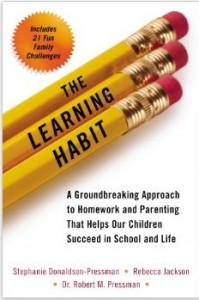Creating a homework routine

 This is the first year homework has really started to affect our family.
This is the first year homework has really started to affect our family.
Homework until now has been predictable and tear-free. Now that my oldest is in third-grade, that’s changing. He often feels overwhelmed, with stacks of worksheets coming home. He sloppily rushes through the homework some days, and stares at it crying on others.
I feel his pain. I can’t bear the thought of this daily struggle continuing for the next nine years. I want to be helpful without helicoptering. I know if I don’t take the correct approach, I could end up undermining his enthusiasm for learning, and even his ability to do so.
 “The Learning Habit” by Stephanie Donald-Pressman, Rebecca Jackson and Robert Pressman
“The Learning Habit” by Stephanie Donald-Pressman, Rebecca Jackson and Robert Pressman
offers help. The recently released book is based on a study that examined family routines in 46,000 U.S. homes of children in grades K-12.
It offers concrete, research-based guidelines for parents to help their children build habits that will help them succeed not only at school, but in life:
- Children should spend 10 minutes per grade on homework daily — that means 10 minutes for a first-grader and two hours for a high-school senior. There’s no benefit to spending longer, according to the study. The homework time is in addition to bedtime reading.
- Homework comes before screen time, which should be limited. The study found that after 45 minutes of media a day, children’s grades, sleep, social skills and emotional balance start to decline. After four hours of accumulated screen time, children’s GPA dropped a full point.
- Children must experience the consequences of their actions to learn. That means parents shouldn’t deliver forgotten homework or library books to school “just this once.”
- Children should be expected to complete household chores consistently to help them develop grit, which is necessary to pursue challenging tasks. (More elementary school children have cell phones than make their beds, according to the research.)
With this guidance in mind, my family has overhauled our routines. After school, the boys munch on a snack and we chat for a while. Then we start the timer on homework. For my third-grader, that’s 30 minutes a day. If he has more than he can do in that time, it will go unfinished. If he has less, he will read, write or rehearse multiplication tables. This way he learns that rushing doesn’t get him anywhere, but he won’t be stuck doing homework all afternoon.
I had been hovering and correcting his work as he went along. No longer. I let him know I’m available to answer questions, but I won’t do his work or fix it for him. The Learning Habit studies found that parent involvement in homework didn’t improve students’ performance, but undermined their sense of autonomy and motivation. Teachers would see perfect homework but poor test scores.
Even after these changes, homework time remains stressful. That’s why I’m also trying to teach my sons a relaxation technique outlined in the book: Take a deep breath in through the nose as if “you’re smelling a flower” and blow out slowly through the mouth as if “you’re blowing out a candle” and repeat something like “I can handle this.” If my kids get the hang of it, they can use the technique to overcome anxiety during tests or the other high-pressure situations that come up in life.
My boys aren’t there yet. On a recent afternoon, a math story problem spun my oldest into paroxysms. I wanted to give him the answer and be done with it. Instead, I was the one taking deep breaths and reminding myself that even if he got the answer wrong, he would still be learning.
